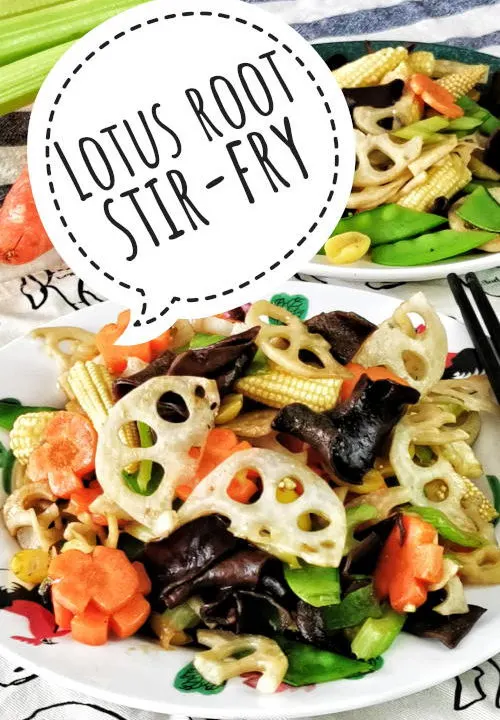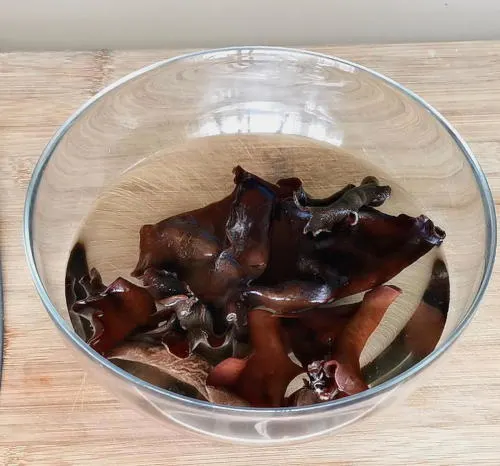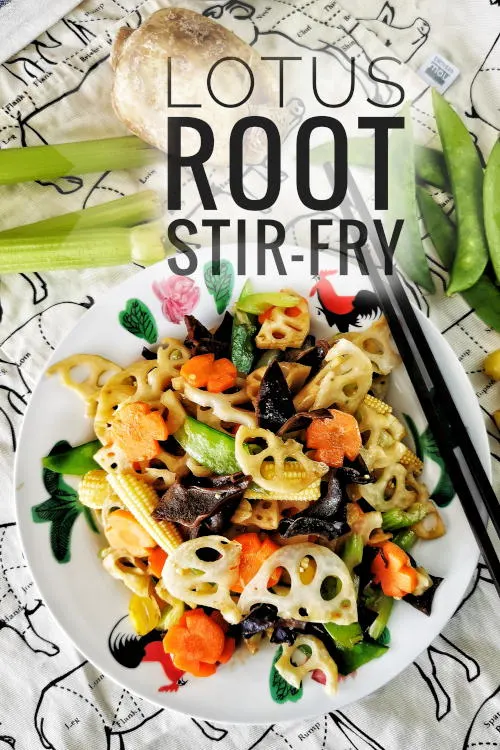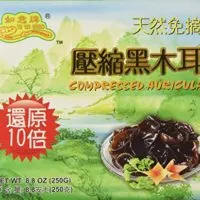If you ask any Chinese family whether they have ever cooked lotus root stir-fry (清炒莲藕) at home, chances are most of them will say yes.
However, if you are a non-Chinese living outside of Asia, you may not have heard of these dishes as it is not the main item in most Chinese restaurants.
Lotus root stir fry is undoubtedly a dish that you should try. The flavor and texture of the lotus root are so unique that hardly any other vegetables can come close to it. It is slightly sweet and earthy and has a crunchy texture when stir-fried. Lotus root is called ‘lian ou, 莲藕’ in Chinese. Although it is called “root,” the rhizome grows horizontally underwater at the bottom of the lotus plant. Besides, stir-fried lotus root also use in traditional Chinese medicine due to its medicinal value.
It comes in connected, cylinder-shaped segments like giant-linked sausages. Seven or nine holes run through each segment and look incredibly attractive if you slice it thinly to reveal the holes, which look like the old-fashioned rotary dial phone.

Note: This post may contain affiliate links. Please read my privacy policy for more info. I may receive commissions for purchases made through links in this post. As an Amazon Associate, I earn from qualifying purchases.
How to cook lotus root stir-fry
Here is the detail on how to prepare the lotus root stir-fry. I suggest you read this article before jumping to the recipe below, especially if you are dealing with lotus roots for the first time.
1. How to prepare the lotus root for stir-frying
Although the lotus root is the rhizome of the lotus plant, not the root, we are so used to calling it lotus root that it is immediately understood its meaning.
How to choose the lotus root
The fresh lotus root should have a heavy feeling in your hand. The color is light brown and should not have cracks, soft spots, and blemishes on the skin. Sometimes it is sold with a few sections linked together, but others may have broken it into separate sections. It is commonly available in the wet market in Malaysia. If you are living outside Asia, it is available at most Asian grocery stores. Sometimes it is also sole in the frozen section when it is off-season.
Clean and cut the lotus root
- To prepare lotus root, peel the skin with a vegetable peeler, cut off both ends, then cut it into round slices, about 2-3 mm crosswise. If you have a large lotus root, half it lengthwise before slicing it into semicircles.
- I suggest using a sharp knife to slice it into thin slices, as it takes a shorter time to cook and produces a crunchier texture.
- Soak the sliced lotus roots in a bowl of water after slicing, as the color of the exposed lotus root darkens quickly. This resembles cutting an apple, where the exposed part will oxidize and turn color. Besides that, it is also helpful to add two teaspoons of white vinegar into the water to make it slightly acidic, which further helps prevent them from turning brown.
- Bring a pot of water to a boil, then blanch the lotus root for one minute. The purpose of blanching is two-folded. First, The cooked lotus root will not change color. Secondly, it shortens the time required during stir-fry since other ingredients take only a minute.
- Drain the blanched lotus root slices in a colander and set them aside for later use.
2. Other vegetables required for this recipe
Although you can stir-fry the lotus root alone, it is tastier by adding other vegetables with different flavors and colors. We usually use celery, carrot, baby sweet corn, and snow peas that compliment the crunchy lotus root. Besides that, lily bulbs, walnuts/peanuts, ginkgo nuts, and wood ear mushrooms are frequently added.
The list of vegetables varies from one chef to the other and can be different according to what is available to cook.
Regardless of what to choose, the choice should follow these simple guidelines:
- To provide different mouthfeels by including vegetables with distinct crunchiness.
- To improve the overall presentation by using vegetables with various colors and shapes.
Prepare the vegetables
Wood ear mushroom 木耳 is also translated as wood fungus and black fungus. You can purchase this item in most Asian grocery stores. It is sold in dehydrated form, which means you need to soak it before use. It absorbs water and expands to more than double in size when soaking in water after twenty minutes. The shape will change from dry to lustrous, shiny, slippery dark brown thick and plum pieces. After it is hydrated, remove the stem, which is hard, then cut it into 1-inch pieces of any shape you prefer. It is commonly available in Asian markets.

Ginkgo nuts are my favorites. First, you must crack the shell with a hammer or knife’s blade and peel off the brownish skin and the inner stem. Alternatively, you can look for those peeled ginkgo nuts sold in vacuum packs to save time.
Carrots need slightly longer to cook than other ingredients, so I suggest blanching them with the lotus root pieces.
Celery and snow peas take only seconds to cook and do not need to blanch in advance. Cut the celery on the bias into thin slices. Snap both ends of the snow peas, then pull away to remove the thin string at the seams. Finally, halve the snow peas diagonally.
Another ingredient suitable for this recipe is green onions (spring onions) cut into short sections.

3. How to season the lotus root stir-fry
I prefer to lightly season the lotus root stir-fry to not overshadow the vegetables’ original flavor. Therefore, I only use oyster sauce, light soy sauce, sugar, and cornstarch to thicken the sauce. Add some salt to adjust the taste before serving if you feel it is not salty enough.
Another spicy lotus root stir-fry recipe includes Szechuan chili bean paste and red chili. I will go for that if I stir-fry only the lotus roots without involving other vegetables. Besides that, you can add some sesame oil, sesame seeds, garlic cloves, and Shaoxing wine to the recipe.
Note: You can substitute oyster sauce with the ‘vegetarian’ oyster sauce made with mushroom extract. Alternatively, replace the oyster with half the light soy sauce and some sugar.
Other related recipes
Lotus root is also a popular vegetable used in soups or stews. This blog has a lotus root soup recipe if you want to make soup. This recipe is based on the time-tested formula prepared with lotus root, pork ribs, and groundnuts.
Bok choy stir fry might be downright simple for some people, especially those who grew up in a typical Cantonese family. However, it is deceptively tricky to recreate this iconic Chinese dish at home to taste like those from the restaurant. Check out the tips in this recipe.

Lotus root stir-fry - quick and easy vegetarian dish
Lotus root stir fry is undoubtedly a dish that you should try. The flavor and texture of the lotus root are so unique that hardly any other vegetables can come close to it. It is slightly sweet, earthy, and has a crunchy texture when stir-fry. Although it is called “root,” the rhizome grows horizontally underwater at the bottom of the lotus plant.
Ingredients
Ingredients A
- 300g lotus root, peeled, sliced
- 2 tsp white vinegar
- Water to soak the lotus root
Ingredients B
- 5 slices ginger
- 1 small carrot, peeled, cut into slices
- 15 Snow peas, snap off both ends, remove strings, halves diagonally
- 25g wood ear mushrooms, soak to hydrate, remove stem, cut into small pieces
- 5 baby corns, cut into 2-3 sections
- 2 stalks celery, cut into thin slices
- 15 ginkgo nuts, membrane, and stem removed
- 1 tbsp vegetable oil
Ingredients C (seasoning)
- 1 tbsp oyster sauce (alternatively use the ‘vegetarian oyster sauce)
- 1 tsp light soy sauce
- 1/2 tsp sugar
- 1/2 tsp salt
- 1/4 tsp ground white pepper
- 1 tsp cornstarch
- 2 tbsp water
Instructions
Preparation
- Cut off both ends of the segments of the lotus. Peel off the skin then cut them crosswise into thin slices, preferably about 2mm thick.
- Soak the slices in water with 2 tsp of white vinegar for ten minutes.
- Blanch the lotus root in boiling water for two minutes, remove, and drain it in a colander.
- Cut the carrots into slices and blanch in water for 2 minutes. Drained. (You can do it with the lotus root simultaneously).
- Snap off both ends of the snow peas, then pull away from the snow peas to remove the fibrous strings. Next, cut the pea in half.
- Soak the wood ear fungus in water for about 20 minutes until fully dehydrated. Remove the hard stem, then cut it into 1-inch pieces.
- Cut the baby corns into 2-3 sections and celery into thin slices.
Cooking
- Heat the oil in a pan.
- Stir fry the ginger until aromatic.
- Add the hydrated wood ear mushrooms and stir fry for one minute.
- Add the blanched lotus root, carrot, and the rest of the vegetables. Stir fry over high heat for half a minute.
- Add the seasonings (ingredients C) and stir fry for another half a minute. Dish out and serve.
Recommended Products
As an Amazon Associate and member of other affiliate programs, I earn from qualifying purchases.
-
 Premium Dried All Natural Compressed Chinese Auricularia Black Fungus Mushroom (Black Wood Ear Mushroom) - 8.8 Oz -- 10 Times Volume Yield After Soaking
Premium Dried All Natural Compressed Chinese Auricularia Black Fungus Mushroom (Black Wood Ear Mushroom) - 8.8 Oz -- 10 Times Volume Yield After Soaking -
 Lee Kum Kee Vegetarian Mushroom Flavored Stir-Fry Sauce, 1.25 Pound (Pack of 12)
Lee Kum Kee Vegetarian Mushroom Flavored Stir-Fry Sauce, 1.25 Pound (Pack of 12) -
 GreenPan Rio 5QT Ceramic Non-Stick Covered Skillet with Helper Handle, Black - CW000058-003
GreenPan Rio 5QT Ceramic Non-Stick Covered Skillet with Helper Handle, Black - CW000058-003 -
 Lodge 14 Inch Cast Iron Wok. Pre-Seasoned Wok with Flattened Bottom for Asian Stir Fry and Sautees
Lodge 14 Inch Cast Iron Wok. Pre-Seasoned Wok with Flattened Bottom for Asian Stir Fry and Sautees
Nutrition Information:
Yield: 3 Serving Size: 1Amount Per Serving: Calories: 836Total Fat: 10gSaturated Fat: 1gTrans Fat: 0gUnsaturated Fat: 7gCholesterol: 0mgSodium: 815mgCarbohydrates: 156gFiber: 30gSugar: 37gProtein: 37g
This data was provided and calculated by Nutritionix on 7/22/2021

KP Kwan
Friday 23rd of July 2021
Hi, this is KP Kwan. I am happy to see you in this comment area, as you have read through my recipe. I am happy to reply to any questions and comments as soon as possible.